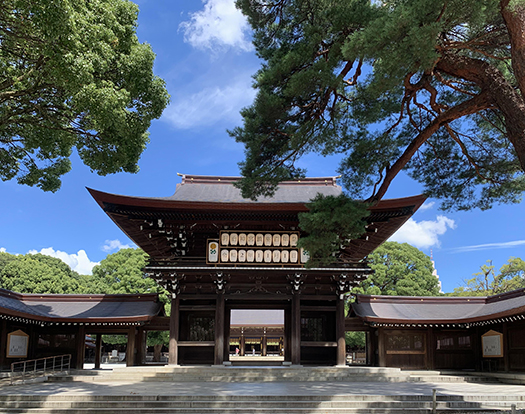

日本の国では本格的に「都」として都市造営されたのは奈良が嚆矢。
その後いくつかの首都都市計画はあったけれど、
京都が造営されて、約1000年とながく首都機能を果たし続けた。
そしていまは東京に首都移転している。約150年超。
なぜか奈良と東京を見比べるというような機会はあまりないかも知れない。
奈良京都とくくった言い方はするけれど奈良東京という言い方はない。
上の写真は鏡池越しの中門・大仏殿の景観。
それに対して下の写真は東京の明治神宮の本殿の手前にある南神門(楼門)。
明治神宮は明治天皇崩御後の大正期に建てられたものですが、
米軍空襲で焼失し、戦後建て直されたもの。
現在は外拝殿までは一般も参観できるけれど、内拝殿から本殿には入れず、
また本殿については写真すら公開されていない。
明治神宮は旧弊のかたまりと化していた京都中心の旧体制の呪縛から抜け出して
天皇自身が東京に居を移し、なお、その死後の鎮魂の場として
全国から植樹して広大な杜を造営し、そのなかに社を建てた神道的神聖空間。
京都から江戸・東京に遷都することはいろいろな意味合いがあったのだろう。
ひとつは関東江戸は永く武家政権の本拠地で
鎌倉幕府の滅亡時期の「いざ鎌倉」的な武家政権神聖地として利用される
内乱要因を摘み取っておくような意味合いが大きかったことと、
欧米との関係を重視し太平洋側に面して開国するという政権意志もあっただろう。
また、対外情勢の対応として対ロシアの北海道侵攻危機があって、
より政権本拠地を東進させる意味合いも大きかっただろう。
東京であれば北方防衛体制は機動的。京都ではおろそかになる。
いずれにせよ、明治開国に当たって天皇権力を再構築するために
その神聖性をより強化する必要性があった。
天平の時代にはアジア世界国際宗教・仏教を統一国家形成に活用したけれど
帝国主義まっ盛りの世界情勢に対応して神道権威を対置する方向に舵を切った。
明治帝は死後にもこうした国家意志表現として祀られたのでしょう。
建築の表現意思としては大仏殿が象徴的なように「公開」して
国家宗教として「布教」的な姿勢を見せていた天平国家の状況が伝わる。
一方で明治神宮には国家の意志としての「非公開」性を感じさせる。
それまでの八百万神的だった牧歌的神社信仰から国家神道に変遷したのでしょう。
大仏殿が「鼻の穴くぐり」みたいに庶民に親和的な表情も感じさせたのに対して
より権威主義的なものに変化していったのでしょうか。
この写真の楼門からさらに「外拝殿」「内拝殿」、さらに非公開の神殿と
建築空間としての深遠な奥行き。それが重厚な人工的森林で被覆されている。
まぁ一種の「タブー」化が進行していたのでしょうか。
天平と明治の国家のありようの違いが伝わってきます。
この明治からさらに令和の今日、このあたりはあまり論考されていませんね。
English version⬇
[Tenpyo and Meiji “Buddhism and State Shinto” Todaiji Temple Revisited-7]
In Japan, Nara was the first city to be built as a “capital” in earnest.
After that, there were some capital city plans, but
Kyoto was built and continued to function as a capital for about 1000 years.
And now the capital has moved to Tokyo. Over 150 years.
For some reason, there may not be many opportunities to compare Nara and Tokyo.
I use the term Nara Kyoto, but not Nara Tokyo.
The photo above is the view of the Great Buddha Hall, the central gate over the mirror pond.
On the other hand, the photo below is the South Shrine (Romon) in front of the main shrine of Meiji Jingu in Tokyo.
Meiji Jingu was built in the Taisho era after the demise of the Emperor Meiji.
It was burnt down in a US air raid and rebuilt after the war.
Currently, the general public can visit the outer hall of worship, but it is not possible to enter the main hall from the inner hall of worship.
In addition, even photos of the main shrine have not been released.
Meiji Jingu escaped from the curse of the old system centered on Kyoto, which had become a mass of old evil
The emperor himself moved to Tokyo, and as a place for his posthumous requiescats.
A Shinto sacred space where trees were planted from all over the country to build a vast forest and a company was built in it.
The transfer of capital from Kyoto to Edo / Tokyo may have had various implications.
One is that Kanto Edo has long been the home of the samurai government.
It is used as a sacred place for the samurai government, which is like “Iza Kamakura” during the fall of the Kamakura Shogunate.
It had a big meaning to pick up the factors of civil war, and
There may have been an intention of the administration to open the country facing the Pacific side with an emphasis on relations with Europe and the United States.
In addition, there was a crisis of Russia’s invasion of Hokkaido as a response to the external situation,
It would have had a great meaning to move the administration base to the east.
In Tokyo, the northern defense system is flexible. It is neglected in Kyoto.
In any case, in order to rebuild the power of the emperor in the opening of the Meiji era
There was a need to further strengthen its divinity.
During the Tenpyo era, Asian world international religions and Buddhism were used to form a unified nation.
In response to the world situation in the height of imperialism, he turned to confront Shinto authority.
The Meiji Emperor would have been enshrined as such a national will expression even after his death.
As for the intention to express architecture, the Great Buddha Hall is “open” as symbolic
It conveys the situation of the Tenpei nation, which had a “promotional” attitude as a national religion.
On the other hand, Meiji Jingu makes us feel “private” as the will of the nation.
Perhaps it has changed from the pastoral shrine belief that was eight million myriads to the state Shinto.
Whereas the Great Buddha Hall made the common people feel a friendly expression like “going through the nostrils”
Has it changed to something more authoritarian?
From the tower gate in this photo, there are “outer hall of worship”, “inner hall of worship”, and a private temple.
Profound depth as an architectural space. It is covered with heavy artificial forest.
Well, was a kind of “taboo” going on?
You can see the difference between the nations of Tenpyo and the Meiji era.
From this Meiji era to the day of Reiwa, there is not much discussion about this area.
Posted on 10月 4th, 2021 by 三木 奎吾
Filed under: 住宅マーケティング, 日本社会・文化研究







コメントを投稿
「※誹謗中傷や、悪意のある書き込み、営利目的などのコメントを防ぐために、投稿された全てのコメントは一時的に保留されますのでご了承ください。」
You must be logged in to post a comment.